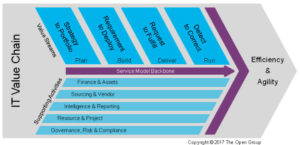
What Is IT4IT & Why Do We Need a New Standard?
IT4IT is a vendor-neutral, open-standard reference architecture and value chain-based operating model for managing the business of IT, developed by The Open Group. The IT4IT reference architecture provides prescriptive guidance to design, source and manage services in a business value chain-based framework called the IT Value Chain.
Organizing around the IT Value Chain professionalizes IT to the level of other key departments in the business such as finance, supply chain, etc. The data-driven IT4IT reference architecture enables insight for agile improvement that brings an increased IT focus on business outcomes.
Image source: opengroup.org
Mark took us through the journey of how IT4IT adoption helped ServiceNow in building solutions that encompass service management and automation functionalities that facilitated end-to-end IT transformation for customers. With the new framework standardizing common functionality, data and interfaces, it enables easier interoperability within the IT management ecosystem.
Are IT leaders — who are often skeptical about new IT architecture plans — ready to adopt this standard? Yes. Mark pointed out that current best practices, including ITIL, COBIT, SCRUM, etc., might provide a standard delivery model on how to operate IT, but organizations end up doing a lot of customization and maintenance efforts while building their IT environment. IT4IT, on the other hand, offers a prescriptive approach with data models, API specification, and functional map for automating the layer of disconnected activities, beyond ITAM and ITOM. Enterprise infrastructure architects play an important role in bridging the gap between the IT and business demands, often making the case for big changes when needed.
Can IT4IT Reference Architecture Support Real-World Use Cases?
The IT4IT reference architecture provides prescriptive guidance on the specification of and interaction with a consistent service model backbone and supports real-world use cases driven by cloud-sourcing, agile, DevOps and service brokering. The IT4IT operating model allows the IT function to achieve the same level of business discipline, predictability and efficiency as other functions in the business, across all of the four value streams (listed below) in the IT value chain.
Strategy to Portfolio
Request to Fulfill
Requirement to Deploy
Detect to Correct
With ServiceNow supporting all of the four IT value streams, customers using the Zenoss-ServiceNow integration can provide the shared resource for teams to work together efficiently and effectively during service disruptions. Zenoss gathers and automatically populates relevant data into incident tickets, eliminating delays from manually gathering incident details and notifying other teams of service disruptions. The bidirectional, consistent information flow with key ticketing systems provides current, accurate and actionable information required to quickly begin the resolution process and address issues before disruptions occur — allowing IT Ops and IT service management (ITSM) teams to be closely aligned and able to seamlessly share relevant issue information, driving better business outcomes with service assurance.
GalaxZ17 sponsors included: SOPRIS Technologies, LayerX Technologies, ServiceNow, Cascadeo, Big Panda, Higher Logic, SaltStack, VictorOps, Verinon, SoftServe, NTT DATA, Everbridge and Broadsuite Media Group.







